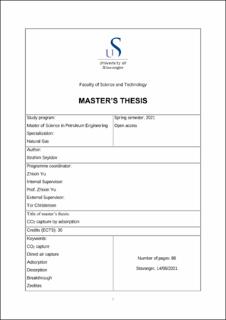| dc.description.abstract | The increasing concentration of CO2 in the atmosphere entails casualties, mainly global warming issues. For quite a long time, considerable efforts have been dedicated to suppressing this issue. Amongst the proposed solutions, direct air capture (DAC) is deemed to be one of the most promising technologies in the future for mitigating the challenges caused by carbon dioxide.
In this thesis project, CO2 removal by the DAC method using a suitable adsorbent, namely, zeolite, is studied. Adsorption and desorption processes on the Z8 test plant are implemented by applying the temperature swing adsorption (TSA) principle.
The test facility Z8 at Greencap Solutions includes a packed adsorbent bed and advanced instrumentation and control systems. It contains three adsorption columns, two of which are for water removal before the carbon capture. For moisture removal from flowing air, silica gel desiccant is deployed.
The CO2 capture process is done by the flowing air over a packed bed of zeolite beads. CO2 initially gets captured at the bed inlet, and after the progression of the capture process, the zeolite beads near the packed bed inlet becomes saturated with CO2, and CO2 is captured further into the bed. Near the end of the capture process, CO2 is detected at the outlet of the packed bed, initially at very low concentrations. The concentration augments with time, and this is called breakthrough, and the CO2 concentration trends a breakthrough curve.
Based on the breakthrough curves, the adsorption rate was examined, the amount of captured CO2 was calculated both till breakthrough and complete test. In addition, the pressure drop during the adsorption process was also investigated and compared with the Ergun equation to have a better realization. It was found that a higher flowrate caused a faster breakthrough. Regarding the adsorption capacity, small size showed the highest capacity due to more active sites on the surface. However, as the adsorbent particle size declined, it caused more pressure drop due to the fewer void fractions.
Eventually, considering the obtained results from the experiments, a conclusion is made, and further work for improving the test plant is suggested. | |
